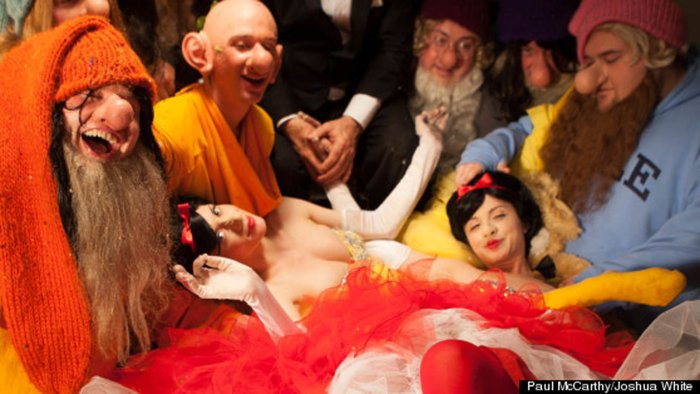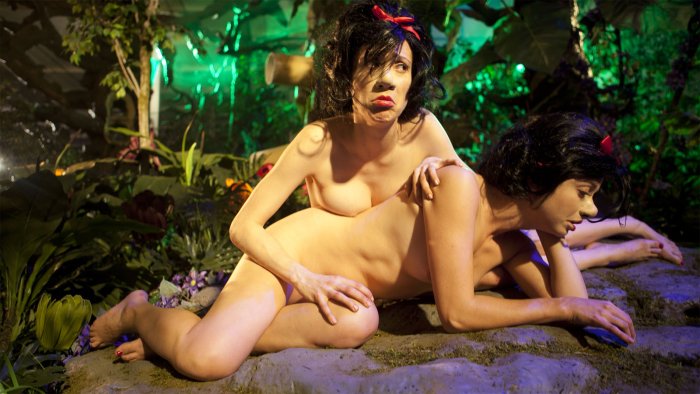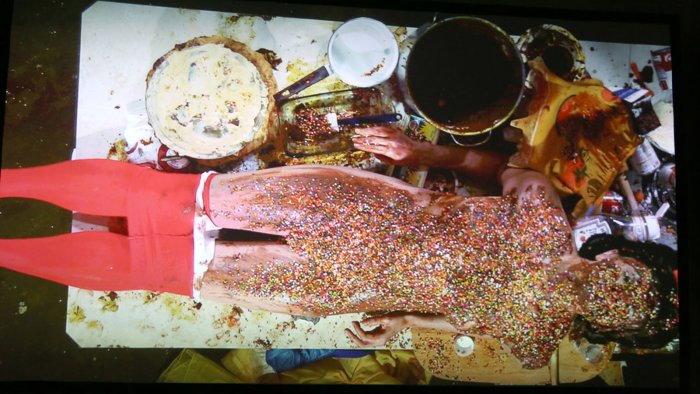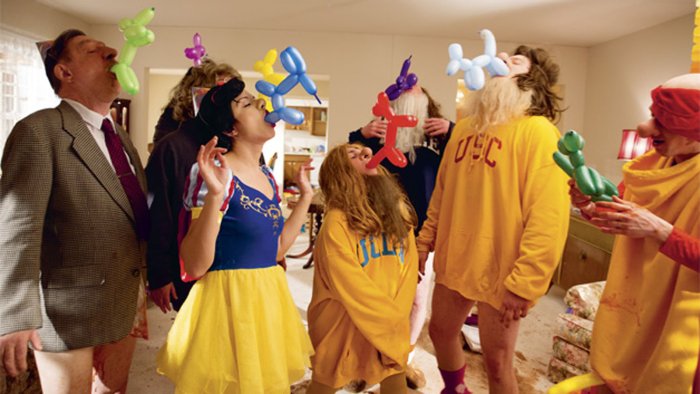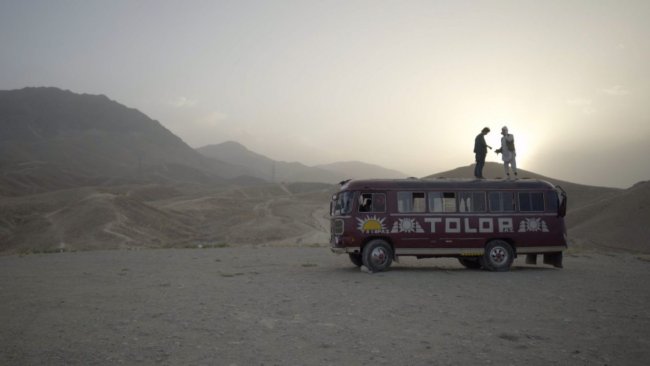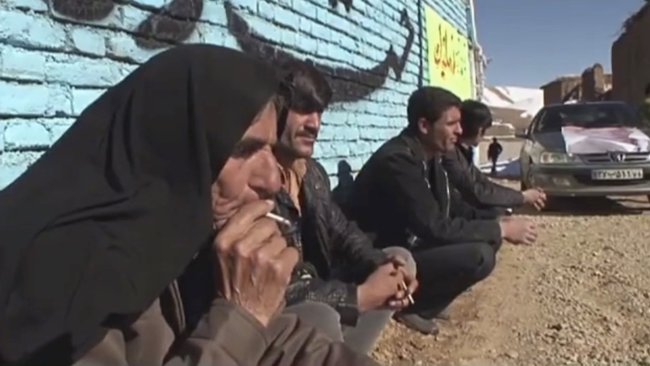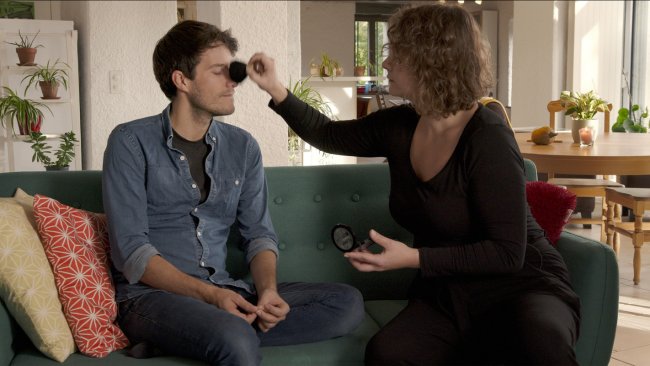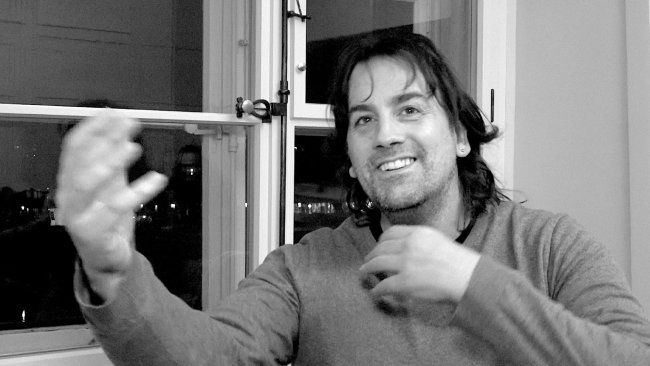White Snow 4 Channels
[…] This is one occasion for us to realize what a strong counterweight simulation is to the performative core of the film. «White Snow» shows a lot, but it actually means even more; it also shows what it is to mean something.
[…] At the Lokremise, «White Snow» raises the more general question of vision and visibility, more precisely: the question of the pornographic destiny of the performative or theatrical representation. That is the most important question regarding the film’s meaning and the necessity of revealing everything and the nakedness of what is seen.
Text: Giuseppe Di Salvatore
With support and protection from the most powerful art gallery in the world (Hauser & Wirth, Zurich) and in collaboration with the Kunstmuseum St. Gallen (where a Paul McCarthy exhibition was installed as the final curatorial project by Konrad Bitterli together with Laura Bechter, curator of the Ursula Hauser collection), the Kinok St. Gallen screened a filmic reworking of White Snow (2009) by Paul and Damon McCarthy in the Lokremise. The caption from the 2009 multi-screen installation has become the title of the 2016 film: White Snow 4 Channel, Single Projection, 7 Hours. This mutation mirrors the evolution of the Lokremise as a cultural place: in 1999 Hauser & Wirth transformed the Lokremise into an art-space, with its post-industrial flavour, and opened it with an exhibition by Paul McCarthy. After some needed repairs and restructuring, the canton of St. Gallen reopened the Lokremise in 2010 as a cultural centre for art, dance, theatre and cinema. Now, Paul McCarthy’s work finds its location in a cinema theatre, the Kinok: Cinema in der Lokremise. Paul McCarthy seems destined to be the genius loci of the Lokremise in St. Gallen.
A lot of information is provided to help understand the reasons behind the projection of a seven-hour film by Paul and Damon McCarthy in St. Gallen. Some understanding is necessary, as the “reduction” of their White Snow project into a single filmic projection is not a diminution but a radicalization of the highly provocative gesture of the artists. Someone who is not already accustomed to Paul McCarthy’s world and aesthetics would easily be shocked to find such a film in her/his beloved cinema. Before entering the theatre, a woman reminds us that we can interrupt the viewing whenever we like and come back later... This condition of freedom notwithstanding, once in the cinema we cannot help but have a completely different experience in comparison to the one in the openness of an exhibition space; and that is very good news.
Once in the darkness of Kinok, we have the chance to appreciate the complexity of what can be viewed as an unprofessional home movie, full of obscenities. The limits between a real performance and theatrical sham are constantly blurred, partly through McCarthy’s play with the home-movie format. Some performers, including Paul McCarthy himself, use the camera, while bigger hidden cameras follow the evolution of this infinite orgiastic party: the objective audience-oriented gaze and the subjective selfie-oriented gaze live ambiguously side by side. The 4 channels build a stimulating counterpoint of images, which is always contrasting with the apparent spontaneity of the action. White Snow shows an intriguing compromise between recognizable patterns and pure improvisation, like in a jazz jam-session.
But what do we see, really? White Snow, in multiple forms as three girls, Walt Disney (played by Paul McCarthy himself), and the seven dwarfs, all living in a typical American house with a fabulously kitsch garden, simply partying: eating, dancing, drinking, pissing and shitting, and drinking again, in a collective escalation of mess and destruction, under the mythical and traditional umbrella of birthday parties. The masturbation/copulation movement of the bodies constitutes the steady basso continuo of the almost choreographic evolution of the group. And, considering the ease with which the men and women get naked, one is astonished that they never “actually” copulate or masturbate – even in the shitting scenes they openly recur only to fake shit as a substitute. This is one occasion for us to realize what a strong counterweight simulation is to the performative core of the film. White Snow shows a lot, but it actually means even more; it also shows what it is to mean something.
The meaning is straightforward: the American mythology of White Snow (or Snow White), her innocence, and the bourgeois illusions around her are depicted and exaggerated, pushed to implosion, finally revealing their intimate violence and vulgarity. Paul McCarthy shows «the dark side of Hollywood», provokes and subverts American values, thus denouncing their core of machismo and bestiality. That is the “official” critical reception of McCarthy’s work, which consecrates him as subversive; an uncomfortable-but-interesting, putrid-but-cool artist. But I want to resist this reception, because it would finally reduce his work to a severe moralism and, eventually, to an indirect puritanism. Also, because what is meant to be subversive often ends up reproducing the logic of that which it tries to subvert; which would certainly not be interesting.
We can gain a better perspective on Paul McCarthy’s work if we equally stress his positive aspects. In the case of the film White Snow, we should recognize an intrinsic ambiguity not only in the formal aspects that I have already mentioned, but specifically in the very content of the film. In fact, watching the film is also a good occasion to bring back our most familiar phantasies: the pleasures of childhood, like sitting inside a fireplace or blowing into flour, the satisfaction in doing absurd and unnecessary things, in messing up, the joy of eroticism. How, and how necessarily, all of this is related to violence and perversion is the very question that makes the ambiguity of White Snow sensible.
This ambiguity, or this more-than-simply-subversive-and-critical feature of White Snow, is the result of a non-superficial viewing of the film, of a longer and more concentrated viewing, which is made possible through its screening in a black box. In a way, it is the specificity of the projection at the Kinok St. Gallen that strongly involves the audience. Moreover, the viewer cannot help but interrogate her/himself as a viewer, a voyeur, an accomplice, a co-performer? At the Lokremise, White Snow raises the more general question of vision and visibility, more precisely: the question of the pornographic destiny of the performative or theatrical representation. That is the most important question regarding the film’s meaning and the necessity of revealing everything and the nakedness what is seen. To this respect, White Snow seems not to be so radical, and even resisting pornography, I would say, as the genital world of White Snow is still more absorbed by childish games and casual eroticism. The very essence of Paul McCarthy’s work, however, is found in the central role of the mask: the mask as illusion (aesthetically and morally), the mask as disfiguration (politically and socially), and the mask as substitution (artistically and existentially).
Info
White Snow 4 Channel, Single Projection, 7 Hours | Film | Paul McCarthy, Damon McCarthy | USA 2016 | 420’ | Kinok – Cinema in der Lokremise, St.Gallen
On the Exhibition at Kunstmuseum St.Gallen
First published: September 29, 2016
